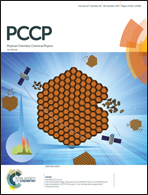Investigation of the dynamics of aqueous proline solutions using neutron scattering and molecular dynamics simulations†
Abstract
We applied quasielastic neutron scattering (QENS) techniques to samples with two different contrasts (deuterated solute/hydrogenated solvent and the opposite label) to selectively study the component dynamics of proline/water solutions. Results on diluted and concentrated solutions (31 and 6 water molecules/proline molecule, respectively) were analyzed in terms of the susceptibility and considering a recently proposed model for water dynamics [Arbe et al., Phys. Rev. Lett., 2016, 117, 185501] which includes vibrations and the convolution of localized motions and diffusion. We found that proline molecules not only reduce the average diffusion coefficient of water but also extend the time/frequency range of the crossover region (‘cage’) between the vibrations and purely diffusive behavior. For the high proline concentration we also found experimental evidence of water heterogeneous dynamics and a distribution of diffusion coefficients. Complementary molecular dynamics simulations show that water molecules start to perform rotational diffusion when they escape the cage regime but before the purely diffusive behavior is established. The rotational diffusion regime is also retarded by the presence of proline molecules. On the other hand, a strong coupling between proline and water diffusive dynamics which persists with decreasing temperature is directly observed using QENS. Not only are the temperature dependences of the diffusion coefficients of both components the same, but their absolute values also approach each other with increasing proline concentration. We compared our results with those reported using other techniques, in particular using dielectric spectroscopy (DS). A simple approach based on molecular hydrodynamics and a molecular treatment of DS allows rationalizing the a priori puzzling inconsistency between QENS and dielectric results regarding the dynamic coupling of the two components. The interpretation proposed is based on general grounds and therefore should be applicable to other biomolecular solutions.



 Please wait while we load your content...
Please wait while we load your content...